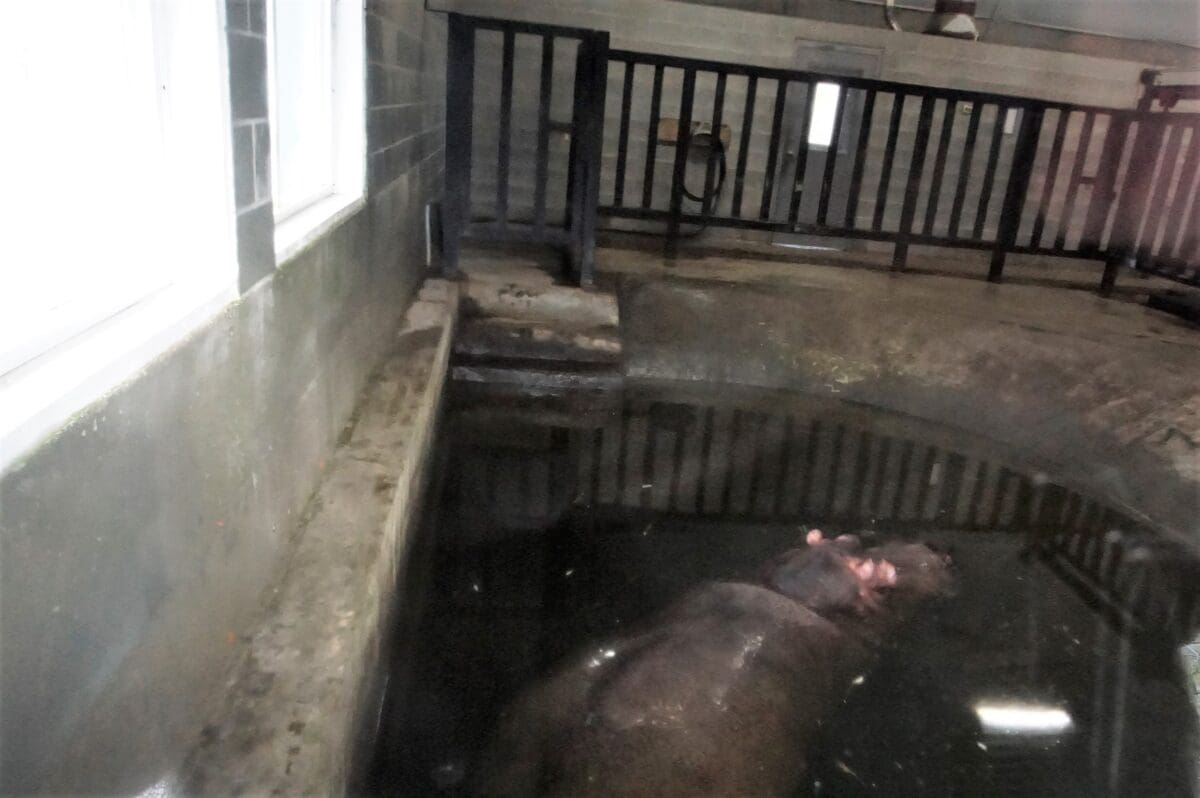Article originally published in The Daily Hive.
In the wild, hippos typically live in social groups of around 10 to 30 individuals. They spend most of their time wallowing in shallow, slow-moving water as they bask in the warm sun of their natural climate. A day in the life of the two hippos at the Greater Vancouver Zoo, siblings Haben and Hazina, looks very different.
The Vancouver Humane Society (VHS) raised concerns about Haben and Hazina’s enclosure following a 2019 report prepared by Zoocheck Canada. The barren winter enclosure does not replicate a natural hippo habitat.
In August 2020, the VHS found that the two hippos had been separated. A sign explained, “Haben has reached sexual maturity and is fighting for dominance … This is normal hippo behaviour that will sort itself out in time”. How much time is unclear; the sign remained as of VHS’s 2022 visit, meaning these normally social animals have been living in contact isolation for at least a year and a half.
A sign that has been posted at the Greater Vancouver Zoo since 2020. Vancouver Humane Society, January 2022
The Toronto Star reported that in 2006, “two charges of cruelty to animals were laid against the zoo … which alleged [Hazina] was being kept alone in a windowless shed with a pool so shallow she couldn’t float.”
If reading about this has left you feeling uneasy about wild, exotic animals in captivity, you aren’t alone. According to a new poll, 89 percent of British Columbians oppose the international trade of exotic animals to be kept on display in permanent captivity in zoos and aquariums.
Why are wild animals still being kept in captivity?
Part of the problem is BC’s loophole-ridden legislation. The keeping, breeding, and transport of exotic species (wild animals not native to BC) is subject to the province’s Controlled Alien Species (CAS) regulation. This regulation is not comprehensive; it is based only on species that pose the greatest threat to public safety and fails to consider animal welfare or a species’ suitability for captivity.
That means animals like the ball python remain unregulated, even though evidence tells us they fare poorly in captivity.
The CAS regulation also allows accredited zoos and aquariums exemptions to keep, breed, and transport prohibited species like hippos.
While requiring that a zoo or aquarium be CAZA-accredited or equivalent may initially sound reassuring, accreditation does not necessarily translate to better welfare for captive animals. Reports from organizations like Zoocheck Canada and VHS, statements from previous zoo staff, and photos and videos all highlight the dark side of accredited facilities. This is because CAZA, or Canada’s Accredited Zoos and Aquariums, is self-regulated by the zoo and aquarium industry and has effectively no incentive to improve the welfare of animals beyond what consumers and the inadequate law demand.
Another stumbling block is public support for zoos and aquariums. While the vast majority of British Columbians oppose transporting exotic animals into the province for display, opinion on keeping captive animals at zoos and aquariums for education and entertainment is split more evenly.
There is a common misconception that most captive animals have been rescued. Zoos and aquariums don’t typically advertise the sources of their animals because they were often bred in captivity or sourced from the wild. For instance, Hana the tiger at the Greater Vancouver Zoo was born at the Seoul Zoo in South Korea.
Many people still believe that breeding and keeping exotic animals in captivity has value to conservation efforts. However, the Greater Vancouver Zoo’s few conservation projects involve only species native to BC.
Intuitively, this makes sense. Why would conservationists invest in breeding exotic animals in a habitat that is far different from what they would naturally experience? If the goal is to eventually reintroduce animals into the wild, efforts would take place somewhere similar to their natural habitat and climate. Breeding animals to be kept perpetually captive does nothing to help conservation efforts. Sadly, the more zoos and aquariums breed exotic animals in captivity, the more animals we condemn to generation upon generation of boredom and psychological distress.
For Haben and Hazina, who were never intended to be released back into the wild, the result is a life confined to a barren enclosure that couldn’t be further from their natural habitat.
The reality is that zoos and aquariums do not have the capacity to fully meet the needs of all the exotic animals they keep. They cannot replicate the size and complexity of a wild and exotic animal’s natural habitat or provide the opportunity for these animals to engage in many of their natural behaviours.
If these facilities were truly interested in conservation, they would stop bringing in or breeding exotic species entirely. They would focus on the conservation of native species, including the rescue, rehabilitation, and release of injured and orphaned wildlife.
But most zoos and aquariums will not make this change on their own. That’s why VHS has launched a petition calling on the provincial government to update the CAS regulation to include animal welfare considerations. With the proposed changes, the regulation would prohibit the keeping, breeding and transporting of all exotic species for permanent captivity; close loopholes; and restrict the captive breeding of native wildlife, unless it is part of a reintroduction program into the wild.
The provincial government has a unique opportunity to create a hopeful future for captive animals. As our understanding of how captive animals suffer has improved, so too must regulations around keeping them in permanent captivity.

